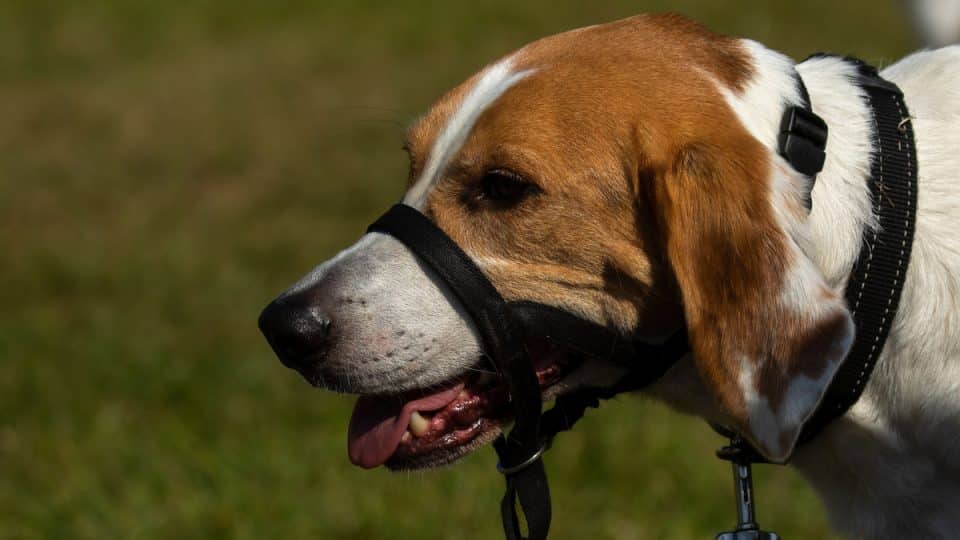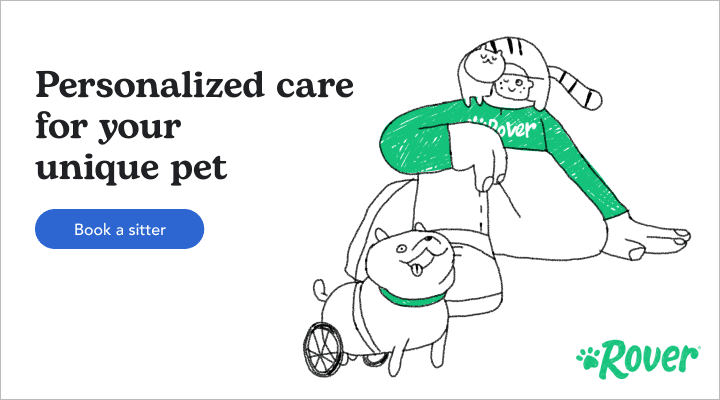- This post contains affiliate links. Read more here.
- Not a substitute for professional veterinary help.
If you’re training your dog to walk on leash, a head collar may be on your radar. But, like many types of training equipment, these tools are hotly debated and shrouded in confusion. Advocates for head collars like the Gentle Leader and Halti consider them safe and effective; others say they’re no better than other types of aversive-based gear. If you’re battling a strong puller or a reactive dog, you may be wondering which side has it right. Do Gentle Leaders work? Or are there better alternatives?
To find out, we speak with professional trainer Leigh Siegfried, CPDT-KA, CEO and founder of Opportunity Barks Behavior & Training. We weigh the benefits and drawbacks of head collars so you can decide whether they’re a good fit for your dog.
How Do Head Collars Work?
At first glance, a head collar may strike the unacquainted eye as intense or restrictive. But understanding how these tools function—and how handlers should use them—can shed light on their relative safety.
How head collars work
Head collars aim to give handlers better control while encouraging good leash manners. They operate on the premise that if you can control a dog’s head, their body will follow.
Design details vary slightly among brands, but all head collars are composed of two loops: one sits high up around the dog’s neck, and a second band loops around the dog’s snout. “Head halters are designed to be worn over the dog’s muzzle with a connection point under the head, similar to a horse or livestock halter,” explains trainer Leigh Siegfried.
Like a horse halter, this system relies on gentle pressure to guide the dog’s movement. When a dog pulls, pressure is applied to the nose, turning their head slightly to the side. This combination of pressure and head movement allows handlers to redirect a dog without yanking forcefully on the lead. Remember: you don’t need a ton of force to accomplish this. A light and gentle hand is all that’s necessary to apply pressure with a head collar.
When a dog stops pulling, it’s critical to relax the leash. This is rewarding to dogs and will motivate them to refrain from tugging on the lead.
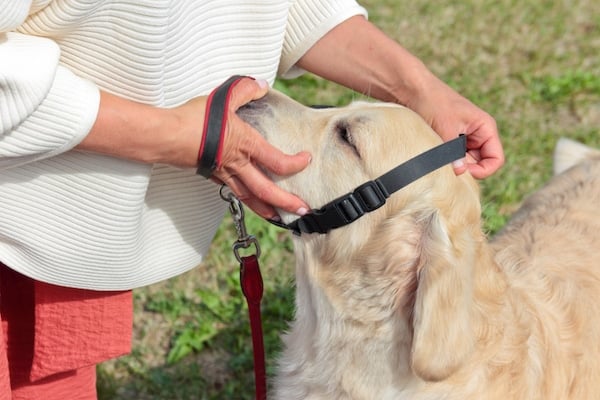
Barcly via iStock
Are head collars safe—or are they cruel?
When used correctly, a head collar is generally considered gentler and more humane than aversive tools like choke, shock, or prong collars. While they may look imposing, it’s worth noting that head collars don’t function the same way that muzzles do. Unlike a muzzle, head collars still allow dogs to pant, bark, drink, and eat.
That said, though plenty of trainers and veterinarians recommend head collars, most dogs find them unpleasant to wear (at least initially), and they can cause injury—just like any tool can become cruel or unsafe when used incorrectly. This means that crates, harnesses, and, yes, even head collars have the potential to be used in a negative way.
In short, the collar itself isn’t cruel or unsafe. But if pet parents aren’t educated on how to use it, or if they don’t put in the time to train their dog, then a head collar can indeed cause discomfort.
How to use a head collar on a dog safely
According to Siegfried, using a head collar safely boils down to two major tenants:
- proper acclimatization of your dog
- handler education
It’s essential to take things slowly, getting your dog used to the new equipment at their own pace. Gradual desensitization is an important first step because a head collar can feel uncomfortable to dogs initially. Some dogs will protest and paw at the unfamiliar device in an attempt to remove it—but this doesn’t mean it hurts the dog.
In fact, a study in Applied Animal Behaviour Science looked at the effects that such restraints have on a dog’s blood pressure, heart rate, pupil dilation, and respiratory rate. The study concluded that, despite frequent nose pawing, dogs were not physiologically stressed when head collars were applied.
So long as the handler uses the head collar correctly, chances of injury are slim. A gentle hand goes a long way, Siegfried points out: “A head halter is a tool of nuance, not something where a dog is guided with lots of pressure on the leash.”
Some tips for using a head collar safely:
- Only apply gentle pressure on the leash
- Never snap or jerk the leash (this risks damaging the neck or spine)
- Size matters: refer to the brand’s sizing instructions or consult with a professional to get the right fit that won’t interfere with your dog’s mouth
- To prevent escape, consider using a head halter in combination with a regular flat collar or harness and a double-ended training leash
- Don’t use a head collar for running or hiking
- Don’t use a head collar with a tie-out or retractable leash
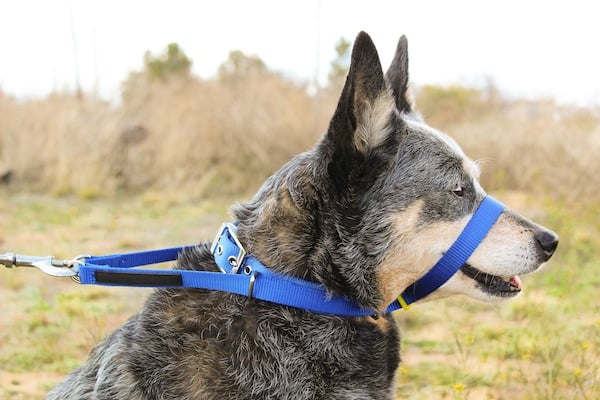
Wind Wolf Photography via iStock
Can head collars discourage dogs from pulling?
Yes! Many pet parents report success using a head collar to curb their dog’s pulling habit. “For some dogs that have been properly acclimated, they can be a life-saving tool and can offer a big quality of life improvement for the dog: more exercise and walking, or even more freedom,” says Siegfried.
Dogs have what’s called an “opposition reflex.” This means that when they feel pressure at the end of their leash, they will instinctively pull forward in response. Most aversive tools fail to address this phenomenon. But head collars (and front-clip harnesses) work by reducing a dog’s opposition reflex.
Even so, they won’t work for every dog that pulls on a leash, says Siegfried.
“Some dogs simply appreciate and do much better on alternative pieces of equipment to guide movement,” she tells us.
It’s important to remember that head collars are not a cure-all for pulling or bad leash manners. They’re a tool, and one that can be very helpful. But, like all tools, a head collar needs to be used alongside training and positive reinforcement.
Also, bear in mind that using a head collar will take time and patience. It may take a while for some dogs to get used to wearing one, and training takes time to stick.
Do head collars teach bad walking habits?
“Handlers teach bad walking habits,” quips Siegfried. While some pet parents express concerns that relying on a Gentle Leader or Halti may lead to poor walking skills, most of the evidence says otherwise. Ultimately, success is in the hands of the trainer.
At the end of the day, a head collar is just a tool: it can certainly help, but it requires consistent training alongside positive reinforcement for dogs to develop better behavior. If a handler expects a head collar to do all the work, they’ll be sorely disappointed with the long-term results. And untrained dogs may revert to pulling once the head halter is replaced with a regular collar.
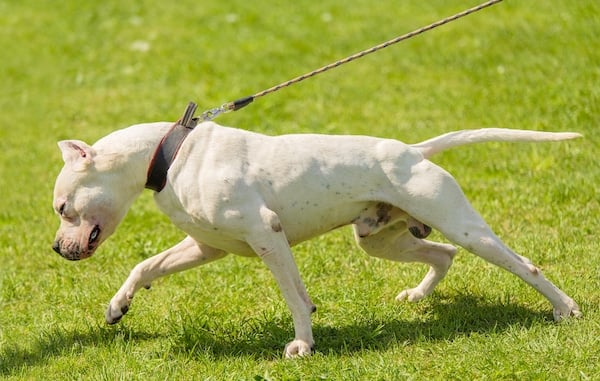
sssss1gmel via iStock
Gentle Leaders Versus Halti—What’s the Difference?
Design-wise, head collars have slight variations. The main difference among brands lies in the position of the leash attachment. Some will have a connection point under the chin, and others connect behind the ears, Siegfried explains.
The two most popular head collars you’ll encounter are the PetSafe Gentle Leader and the Halti OptiFit. These two collars share some functional similarities. But their differences in fit make them better suited to different dogs.
“Both the gentle leader and Halti connect under the chin, but the Halti has a bit of a wider fit for dogs with more room for the muzzle to move freely,” Siegfried remarks.
Whereas the Gentle Leader tends to fit more snugly, the Halti has a more relaxed fit. This makes the Gentle Leader a safer option for escape artists and dogs who need stronger control. The Halti, on the other hand, features wider straps and thicker padding, making it better suited to sensitive dogs who might find the Gentle Leader too restrictive.
The Gentle Leader has a simpler design with fewer straps than the Halti. Generally speaking, it’s easier to get on and off, which is a practical bonus for extra fidgety or nervous pups. They also come in much smaller sizes.
One area where Haltis shine is safety—this head collar features reflective accents and an extra security strap that attaches to your dog’s regular collar.
Here’s a side-by-side overview of the main specs to compare the two for yourself.
| PetSafe Gentle Leader | Halti OptiFit | |
| Sizes & Neck Circumference |
|
|
| Material | Nylon with some padding on nose-band | Nylon webbing with more substantial neoprene padding |
| Strap Width | Thinner straps | Wider straps |
| Fit | Tends to fit more snugly: potentially less comfortable, but more secure for escape artists | Tends to fit more loosely: dogs may find it less restrictive and comfortable to wear |
| Design | Simpler, minimal design: makes it easier to get on & off | Slighly more complex design: extra strap secures the Halti to a dog’s regular collar |
| Colors | 8 colors options | Only one color available |
Final Verdict—Should You Try a Head Collar?
Implementing a head collar can be a real game changer for some dogs. Used correctly, they can help deter pups who pull and give handlers greater control over large, powerful dogs. Plus, they can help redirect reactive dogs who become agitated when faced with certain stimuli.
While they’re helpful for many, a head collar won’t be the answer for everyone. Siegfried reminds us that these tools require patience, and anyone wishing to use a head collar will need to invest time for training and learning how to properly use one.
Moreover, some flat-faced breeds like Frenchies and Pugs won’t do well with a head collar because they won’t fit over their short snouts.
Siegfried reminds pet parents that different equipment will work better (or worse) for certain dogs. Accordingly, dog parents should avoid clinging to certain tools just because they worked for someone else.
“Be open to the head halter as an option, be patient, and don’t be attached,” she says. “If it’s not your tool, it’s not your tool. It’s not a mark of failure on your behalf.”
If you find that’s the case, whether it’s because your dog finds a halter distressing or it just isn’t helping you reach your goals, there are alternatives to try. Siegfried recommends martingale collars and slip leads, which offer more control. For pulling, a front-clip harness can also help. And finally, working with a professional trainer is never a bad idea.
How We Chose
The head collars featured here were selected based on a comprehensive look at customer reviews, extensive research on their use and functionality, and an interview with professional trainer Leigh Siegfried. We focused on safety, efficacy, and comfort. We’re also guided by the experience of living and playing alongside our own much-loved and strongly opinionated pets, who are never stingy with their feedback.
Further Reading
- The Best Training Collars, Leashes, and Harnesses
- The Best No-Pull Harnesses for Tuggers Big and Small
- Navigating Leash Greetings, Clueless Strangers, and Other Common Dog Walking Scenarios
- How To Find a Great Dog Training Class Near You
